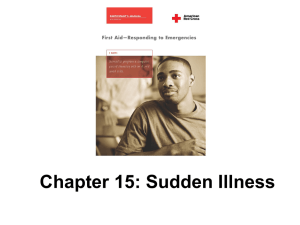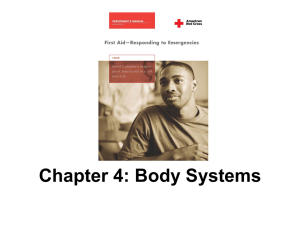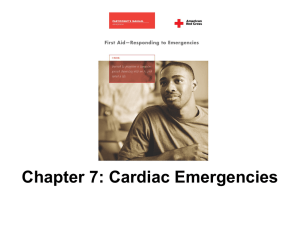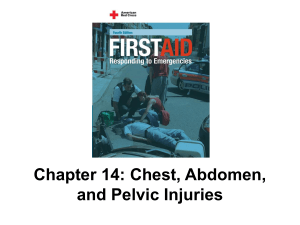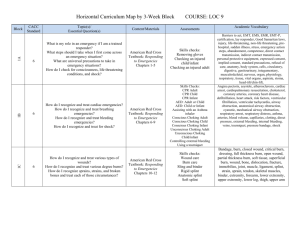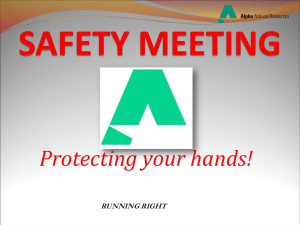Before Giving Care
advertisement
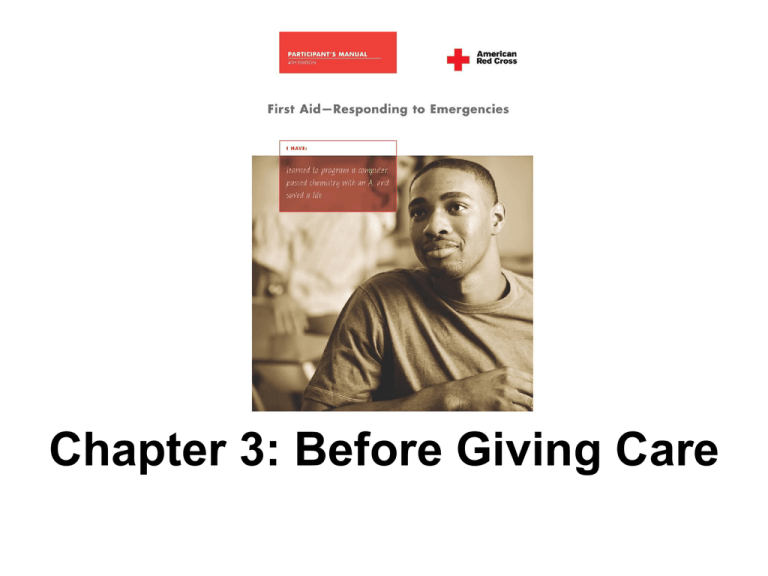
Chapter 3: Before Giving Care Introduction In this lesson, you will learn— That your top priority is to ensure your own safety. To protect yourself from disease transmission. How to properly move a victim. The basic legal information you will need to know before giving care. 2 AMERICAN RED CROSS FIRST AID–RESPONDING TO EMERGENCIES FOURTH EDITION Preventing Disease Transmission Diseases that can pass from other people, animals, insects or things are called infectious diseases. Four conditions must be present for a disease to be transmitted. If any of these conditions are absent, disease transmission is not possible: A pathogen is present. Enough of the pathogen is present to cause infection. The pathogen passes through an entry site (eyes, mucus membranes, open cuts in skin). A person is susceptible to the pathogen. Diseases can be spread through direct contact transmission and indirect contact transmission. 3 AMERICAN RED CROSS FIRST AID–RESPONDING TO EMERGENCIES FOURTH EDITION Preventing Disease Transmission Give care in a manner that minimizes the risk of disease transmission. Standard precautions is an approach to infection control that encourages you to consider all bodily fluids as infectious and to follow safety measures to prevent exposure. Good personal hygiene habits, such as frequent hand washing, help to prevent disease transmission. Personal protective equipment is the equipment that helps keep you from direct contact with infected materials. To learn more about preventing disease transmission, enroll in an American Red Cross Bloodborne Pathogens Training: Preventing Disease Transmission course. 4 AMERICAN RED CROSS FIRST AID–RESPONDING TO EMERGENCIES FOURTH EDITION Removing Disposable Gloves Partially remove the first glove by pinching the glove at the wrist, being careful to touch only the glove’s outside surface. Pull the glove toward the fingertips without completely removing it. The glove is now partially inside out. With the partially gloved hand, pinch the exterior of the second glove. Pull the second glove toward the fingertips until it is inside out and then remove it completely. Grasp both gloves with your free hand, touching only the clean interior surface of the glove. Discard the gloves in an appropriate container. Wash your hands thoroughly with soap and water. 5 AMERICAN RED CROSS FIRST AID–RESPONDING TO EMERGENCIES FOURTH EDITION Obtaining Consent to Give Care One important aspect of giving care is to get permission. Before giving care to a conscious adult, get consent to give care. To get consent, you must tell the victim: Who you are. Your level of training. The care you would like to give. 6 AMERICAN RED CROSS FIRST AID–RESPONDING TO EMERGENCIES FOURTH EDITION Obtaining Consent to Give Care (continued) Do not give care to a conscious victim who refuses it. Special situations: The conscious victim is an infant or child. When the victim is unconscious or unable to respond because of illness or injury, consent is implied. 7 AMERICAN RED CROSS FIRST AID–RESPONDING TO EMERGENCIES FOURTH EDITION Good Samaritan Laws All states have enacted Good Samaritan laws. This is a law that protects citizen responders who are willing to provide emergency care to injured or ill persons without accepting anything in return. 8 AMERICAN RED CROSS FIRST AID–RESPONDING TO EMERGENCIES FOURTH EDITION Reaching and Moving Victims You should move a victim only when you can do so safely and when there is an immediate danger. Before you act, consider the following limitations to ensure moving one or more victims quickly and safely: Dangerous conditions at the scene The size of the victim Your physical ability Whether others can help you The victim’s condition 9 AMERICAN RED CROSS FIRST AID–RESPONDING TO EMERGENCIES FOURTH EDITION Emergency Moves Four common types of emergency moves are: Walking assist. Pack-strap carry. Two-person seat carry. Clothes drag. 10 AMERICAN RED CROSS FIRST AID–RESPONDING TO EMERGENCIES FOURTH EDITION Closing Consider your own safety. Protect yourself from disease transmission. Check the scene for safety. Obtain consent. If you must move a victim, be sure to do so in a manner that is safe for you and will not cause the victim any further harm. Questions? 11 AMERICAN RED CROSS FIRST AID–RESPONDING TO EMERGENCIES FOURTH EDITION
